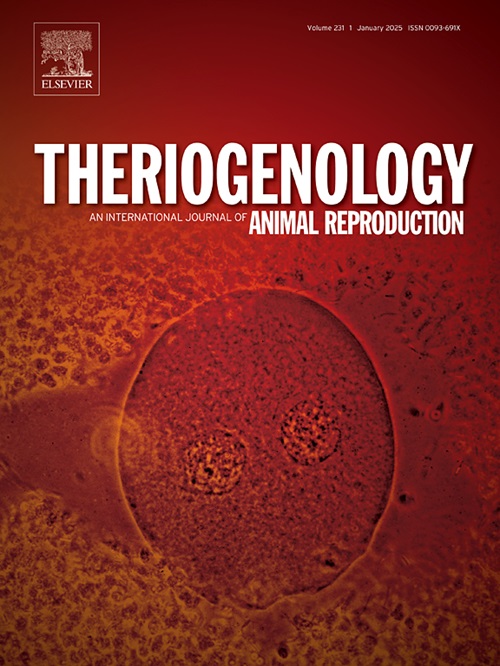微纳米塑料污染与哺乳动物的生育能力:系统回顾和荟萃分析
IF 2.4
2区 农林科学
Q3 REPRODUCTIVE BIOLOGY
引用次数: 0
摘要
微塑料和纳米塑料(MNPs)是塑料物品的物理、化学或生物降解产生的碎片。MNPs是海洋和陆地塑料污染的主要来源之一。本研究对MNPs中主要塑料成分(聚苯乙烯(PS)、聚乙烯(PE)、聚丙烯(PP)、聚对苯二甲酸乙二醇酯(PET)和聚氯乙烯(PVC))对哺乳动物的生殖毒性进行了系统和荟萃分析。使用PubMed、Medline和CAB Abstracts数据库识别相关科学论文,并选择79篇文章进行系统评价。6篇文章包含两个不同的物种,19篇论文同时包含体内和体外研究,因此在meta分析中总共考虑和分析了102个实验。对MNPs对哺乳动物的生殖毒性的兴趣有所增加,在过去两年中达到顶峰。研究了五个物种(大鼠、小鼠、牛、猪和人),大多数实验在小鼠体内进行,重点关注雄性生育能力。研究最多的塑料聚合物是PS,微粒子和纳米粒子都在单一或多个浓度下进行了测试。毒性效应被记录在不同的物种、颗粒大小和聚合物类型中。已观察到明显的浓度依赖性毒性,特别是在高浓度/高剂量的MNPs下。对食品生产动物的研究存在空白,这些动物既是人类健康的相关模型,也是MNPs进入人类食品供应链的潜在媒介。总的来说,这些发现强调了继续研究阐明MNPs影响哺乳动物生殖健康的途径和机制的重要性,最终促进了我们对这些普遍存在的污染物如何与不同物种的生物系统相互作用的理解。本文章由计算机程序翻译,如有差异,请以英文原文为准。
Micro-nanoplastics pollution and mammalian fertility: A systematic review and meta-analysis
Micro
and nanoplastics (MNPs) are fragments derived from physical, chemical, or biological degradation of plastic items. MNPs are one of the main sources of both marine and terrestrial plastic pollution. This study systematically and meta-analytically assesses the reproductive toxicity in mammals of key plastic components found in MNPs, focusing on polystyrene (PS), polyethylene (PE), polypropylene (PP), polyethylene terephthalate (PET), and polyvinyl chloride (PVC). PubMed, Medline, and CAB Abstracts databases were used to identify the relevant scientific papers, and 79 articles were selected for the systematic review. Six articles included two different species, and 19 papers contained both in vivo and in vitro studies, resulting in a total of 102 experiments being considered and analysed in the meta-analysis. Interest in the reproductive toxicity of MNPs in mammals has increased, peaking in the last two years. Five species (rat, mouse, bovine, pig, and human) have been studied, with most experiments carried out in vivo in mice, focusing on male fertility. The most studied plastic polymer is PS, and both micro- and nanoparticles were tested at single or multiple concentrations. Toxic effects are documented across various species, particle size, and polymer type. A pronounced concentration-dependent toxicity has been observed, particularly at high concentrations/doses of MNPs. There is a gap in research on food-producing animals, which are both relevant models for human health and potential vectors for MNPs into the human food supply chain. Overall, these findings emphasizpe the importance of continued research to elucidate the pathways and mechanisms through which MNPs impact mammalian reproductive health, ultimately advancing our understanding of how these pervasive pollutants interact with biological systems across diverse species.
求助全文
通过发布文献求助,成功后即可免费获取论文全文。
去求助
来源期刊

Theriogenology
农林科学-生殖生物学
CiteScore
5.50
自引率
14.30%
发文量
387
审稿时长
72 days
期刊介绍:
Theriogenology provides an international forum for researchers, clinicians, and industry professionals in animal reproductive biology. This acclaimed journal publishes articles on a wide range of topics in reproductive and developmental biology, of domestic mammal, avian, and aquatic species as well as wild species which are the object of veterinary care in research or conservation programs.
 求助内容:
求助内容: 应助结果提醒方式:
应助结果提醒方式:


